The Acropolis of Athens Old Museum
IntroductionThe Museum existing until lately on the Acropolis rock was considered among the most important ones in the world and definitely the most important one as far as the History of European Art is concerned. It was built on the Acropolis Hill in 1874, in such a way that it would not aesthetically interfere with the Temples, nor be visible from anywhere within the city of Athens.
The excavations that followed, toward the end of the 19th century, unearthed a wealth of finds which were impossible to exhibit in the limited space of the Museum. Thus, the inscriptions, bronzes, clay objects, and a variety of other items were kept in the National Archaeological Museum, where they were originally taken for conservation. The situation was aggravated after all the marble pieces were removed from the Parthenon Friezes (that is, what was left over after Elgin's plunder) and were put in the museum, together with the Caryatids (the marble statues of the women supporting the roof of the south porch of the Erechtheion), all of which were removed to be kept in an air-tight window containing nitrogen, so as to stop air pollution from deteriorating the marble surfaces.
The collections of the museum included:
Sculptural offerings of the Archaic period
Pediments of temples dated to the Archaic period
Archaic Horsemen
Sculptures of the "Severe" style
Pediments and metopes from the Parthenon
The Parthenon frieze
The Erechtheion frieze
Parapets of the Athena Nike temple
Frieze of the Athena Nike temple
The Caryatids
Clay figurines and vases from the sanctuary of the Nymphs.
Everyone was eagerly anticipating the completion of the new Acropolis Museum, for the total wealth of finds related to the Acropolis and the Parthenon to finally be exhibited in the best possible way (combining location, lighting, space, air filtering and thematic consistency), and thus deprive the descendants of Lord Elgin of all plausible excuses to insist that the Parthenon Marbles continue to be kept separated from the rest of their like and the Parthenon remain in its mutilated state.
During 2008, the exhibits of this Museun were transferred to the New Museum, the erection of which was completed. Three huge cranes were used to carry all the heavy marble statues and exhibits, a total of some 4,500 artifacts from the old, cramped Acropolis museum, a task that was the biggest airlift of antiquities in Greek history. It was the first time the artifacts — some of which are considered among the most important works of antiquity — were moved from the very Acropolis Rock. This transfer was completed in the end of spring but putting up the exhibits in their right place would take a lot longer.
We thought that the present Album would become useless after the New Museum's inauguration. Nevertheless, the decision of the museum authorities to prohibit taking photographs of the exhibits in their new surrounding created more problems than the ones it was supposed to solve. We admit that the decision was well meant, but, with all due respect, we would like to point out that times have changed; we are afraid that whatever is not shown online cannot achieve the level of promotion that it may be worthy of. We managed, though, to get a number of photos of the exhibits, as the decision was taken a couple of weeks after the museum's inauguration. We are working on them and will do our best to put them up as soon as possible. But, in our effort to best present the exhibits, we are sorry to have to use some of the photos taken at the Old Acropolis Museum. Until the New Acropolis Museum album is online, please enjoy the marvellous artifacts at their old "home".
(Photos: Michael Tziotis)
Select Page of the Album:
Click on any of the pictures to enlarge.
Gallery IIPediments and dedications of the first half of the 6th century (600 - 550 BC). Pediment of the triple bodied monster, pediment with the Apotheosis of Herakles (Herakles entering Olympos), a Sphinx, the Moschoforos (calf carrier) and the Kore with the pomegranate. Clay relief plaques, figurines and busts (protomes) are also displayed.
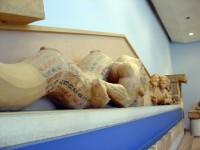
Akr 35-36. Pediment of the Εarliest Parthenon
From the waist down, Triton is a fish; the scales indicated in painted relief, the curves of the fish tail adapted to fit the corner of the pediment. An over-life size head of poros limestone, nr 6608, has been attributed to the figure Herakles; it was found on the Acropolis northern slope and is exhibited nearby. |
|
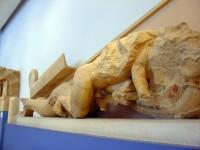
Akr 35-Akr 36. Pediment of the Earliest Parthenon
Two groups of poros limestone sculptures in the two wings of a pediment of the earliest Parthenon. The figures project from the background almost completely and the rich coloring is exquisitely well preserved. The group on the left depicts the wrestling match between Hercules (Herakles) and the sea monster Triton. Heracles is in the foreground kneeling on his outstretched right leg, bracing his left knee against his opponent; Herakles’ arms, (now missing) were locked in a stronghold around the body and the arms of Triton, reducing him to helplessness. |
|
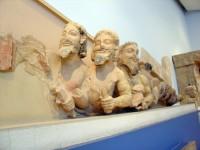
Akr 35-Akr 36. Pediment of the Earliest Parthenon
The right wing of the pediment consists of three bearded male figures, human from head to waist, snakes from the waist down. The first figure carries water, the second fire, and the third one a bird. Great wings unfold from their backs. Above the pediment are sections of the “sime” (gutter) of the temple with spiral “acroteria” at the corners; below are sections of the horizontal cornice of marble coming from the nearby Mt Hymettus with incised and painted lotus and palmette patterns (Please see Gallery I, Akr 4572, Lotus Flower). Second quarter of the 6th century B.C. |
|
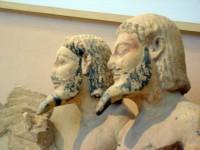
Akr 35-Akr 36. Pediment of the Earliest Parthenon (Detail)
Detail of the first two of the three figures referred to in the previous photo. |
|
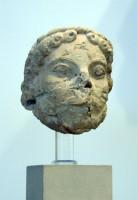
Akr 6508. Poros Head Attributed to Herakles in Pediment Akr 35-36
Also distinguishable in the far end of the photo above |
|
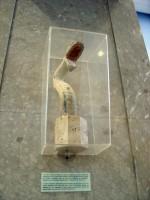
Akr 41. Poros Limestone Snake
Poros limestone snake with raised head and wide-opened jaws, one of the snakes coming out from the arms and the chest of the Triple-bodied Monster on pediment Akr 36. Fragments of more snakes are preserved. Incised and painted details. Second quarter of the 6th century B.C. |
|
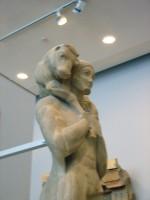
Akr 624. “Moschoforos” The Calf-Carrier
The statue of a bearded young man made of marble from Mt Hymettus. He wears a short “himation”, the ends of which are symmetrically arranged down his front and he is carrying a calf on his shoulders for a sacrifice to the goddess. His face is animated by his smile and the expression of his eyes, which originally had inset pupils, perhaps made of rock crystal. The sculptor has succeeded in expressing the special bond between man and beast by means of the composition: juxtaposing the heads and the way in which the hooves of the calf and the man’s hands form the center of an X. The fragmentary inscription on the base preserves the name of the dedicator: [Rhombos]. Around 570 B.C. |
|
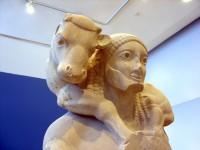
Akr 624. “Moschoforos” The Calf-Carrier |
|
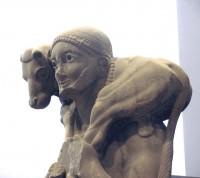
Akr 624. “Moschoforos” The Calf-Carrier |
|
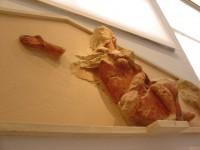
Akr 2. The “Red Pediment”
Named after the brilliant red color in an excellent state of preservation. Low quality poros stone. The group comes from a small archaic building on the Acropolis and has as its subject matter Herakles wrestling with the sea demon Triton. Herakles’ arms are locked in a stronghold around the shoulders and chest of Triton who stretches his hand in a pleading gesture towards another figure to his left (not preserved). Second quarter of 6th century B.C. |
|
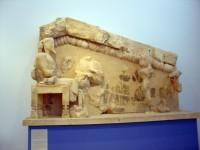
Akr 9. Pediment with the Apotheosis of Herakles
Poros limestone pediment with the Apotheosis of Herakles from a small archaic building on the Acropolis or the earliest Parthenon. At the left, Zeus, seated on a throne, raises his left hand to receive the hero in Olympos, after the successful outcome of his Labors. Beside him, we see Hera seated in frontal pose. Herakles is striding towards them swiftly; he wears a short “chiton” and the lion skin. He is followed by a figure wearing a short “chiton” and an animal skin who is identified as Iris, Zeus’ messenger. Another divine figure, not preserved, must have stood between the gods and the hero: perhaps Herakles’ champion, Athena. The composition is enlivened with strong colors and delicately worked patterns on the borders of the garments. Above the composition is a carved and painted molding (astragalos). Second quarter of the 6th century B.C. |
|
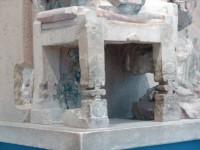
Akr 9. Zeus's Throne Detail |
|
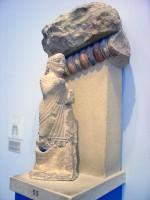
Akr 55. Bearded Man
Bearded man clad in “himation”, advancing towards the right, with his right hand held up to his chest. |
|
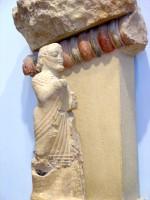
Akr 55. Bearded Man (Closeup)
The figure belongs to pediment nr 9, the Apotheosis of Hercules. |
|
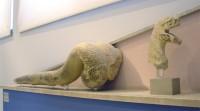
Akr 37 - 40. Two huge snakes of poros limestone
Two huge snakes of poros limestone which come from the corners of a pediment, perhaps the earliest Parthenon. The bodies of the snakes ripple and coil as they advance towards the center of the pediment and their heads (the one on the left only preserved) are raised with wide open jaws. Their scales are rendered in relief, painted in vivid colors of red and green. Second quarter of the 6th century BC. |
|
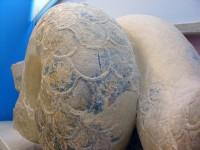
Akr 37 - 40. Two huge snakes of poros limestone
Two huge snakes of poros limestone which come from the corners of a pediment, perhaps the earliest Parthenon. Their scales are rendered in relief, painted in vivid colors of red and green. Second quarter of the 6th century BC. |
|
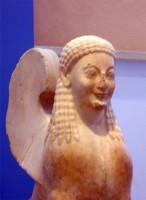
Akr 630. Votive statue of a sphinx
Votive statue of a sphinx made of island marble. It has a frontal pose and once would have been set upon a high stele. Bead-shaped curls tied with a band in back surround her face with big eyes and features. The down on her breast and the wings are rendered in paint. Dated in 560-550 B.C. |
|
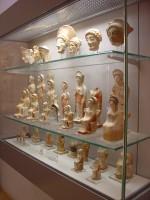
Window A: Terracotta figurines and protomes
The terracotta figurines and female protomes exhibited in case A are typical examples of Attic cοroplastic art in the archaic period, reaching its high point in late archaic times, 520-480 B.C. These mould-made figurines were coated with white slip and brilliantly painted. The dominant colors are red, blue, green and black for rendering hair, garments, drapery, folds and features. There are two main types: The maiden holding an offering and the enthroned goddess. The standard types are often enriched with hand-made or mould-made additions, so that the figures may be recognizable by means of attributes. The figurines of Athena wear a helmet. The seated figures of the Acropolis goddesses have been linked to the cult statue of Athena Polias, the primitive wooden image housed in the Old Temple. The protome is another important dedication of terracotta, i.e. a female head made in one piece with the plaque which has suspension holes. |
|
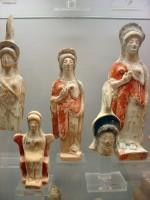
Window A: Terracotta figurines and protomes (Detail)
Second Shelf: Akr 12285 front right, Akr 11670 front left, Akr 10510 back right, Akr 10695 back middle and Akr 11517 back left |
|
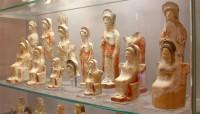
Window A: Terracotta figurines and protomes (Detail) |
|
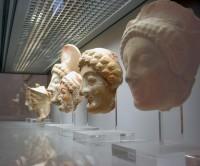
Window A: Terracotta figurines and protomes (Detail)
Top Shelf: Akr 12732 first and Akr 12762 second in the line |
|
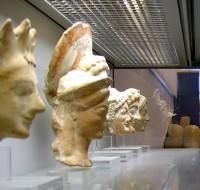
Window A: Terracotta figurines and protomes (Detail)
Top Shelf, opposite side than the one in the previous photo. |
|
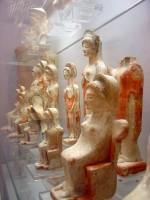
Window A: Terracotta figurines and protomes (Detail-Middle shelf)) |
|
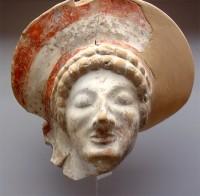
Window A: Votive Protome to Goddess Athena |
|
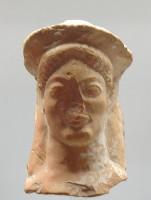
Window A: Votive Protome to Goddess Athena |
|
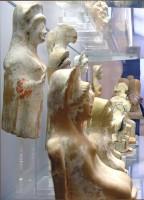
Window A: Terracotta figurines and protomes (Detail) |
|
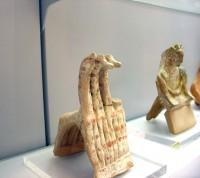
Window A: Terracotta figurines and protomes (Detail)
Votive figurines of four horses drawing a chariot |
|
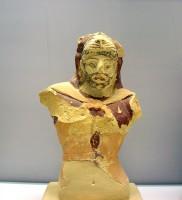
Window A: Terracotta figurines and protomes (Detail)
Votive figurine of Herakles in his lion skin. According to the Myth, Heracles's first labor was to kill the Nemean Lion, a monstrous beast that was terrifying the whole of Nemea region. When they met, Herakles tried to kill it with his arrows, only to find out that the skin of the lion was impenetrable by any weapon. When the lion attacked, the hero struck it with his olive-wood club and managed to kill it by wrapping his arms around his neck and strangle it to death. Then he had to find a way to skin the dead animal, since knives were of no use! The lion's very claw proved to be the only tool sharp enough to pierce the skin, and when skinning was done, the hero wrapped his body with it to offer himself armor protection against his enemies. He pulled the head as a helmet to cover his own and fasten the whole hyde in place! The figurine in the photo shows precisely this detail! |
|
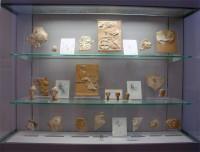
Window B: Terracotta Relief Plaques
Terracotta plaques with painted relief decoration were an important kind of miniature art in antiquity, with votive or funerary function. The Acropolis plaques are part of the dedications of the sanctuary. These mould-made plaques were made in Attic coroplastic workshops and are dated to 500-480B.C. In many the painting on the white coating has been excellently preserved; azure blue is used for the background and red, blue, green and yellow for the garments and other details. The plaques have suspension holes for hanging on walls of buildings in the shrine. The representation of Athena in various aspects is the most frequent composition. Athena appears as the war goddess in full armor, mounting her chariot. At other times, the plaques show the peaceful side of Athena’s worship: the goddess is seated and makes a libation with a phiale, or she is spinning. Other compositions have to do with Artemis, who had her own sanctuary on the Acropolis, the Brauronion, or with legendary heroes (Herakles). |
|
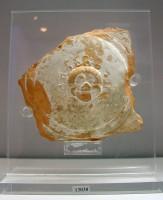
Akr 13030. Window B (Detail): Votive Clay Plaque
Bottom shelf, second from left exhibit in previous photo |
|
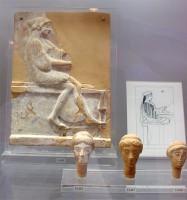
Window B (Detail): Votive Clay Plaque (Akr 13055) and Three Heads (Akr 12442, 12443, 12448) |
|
|
Select Page of the Album:
|
|



